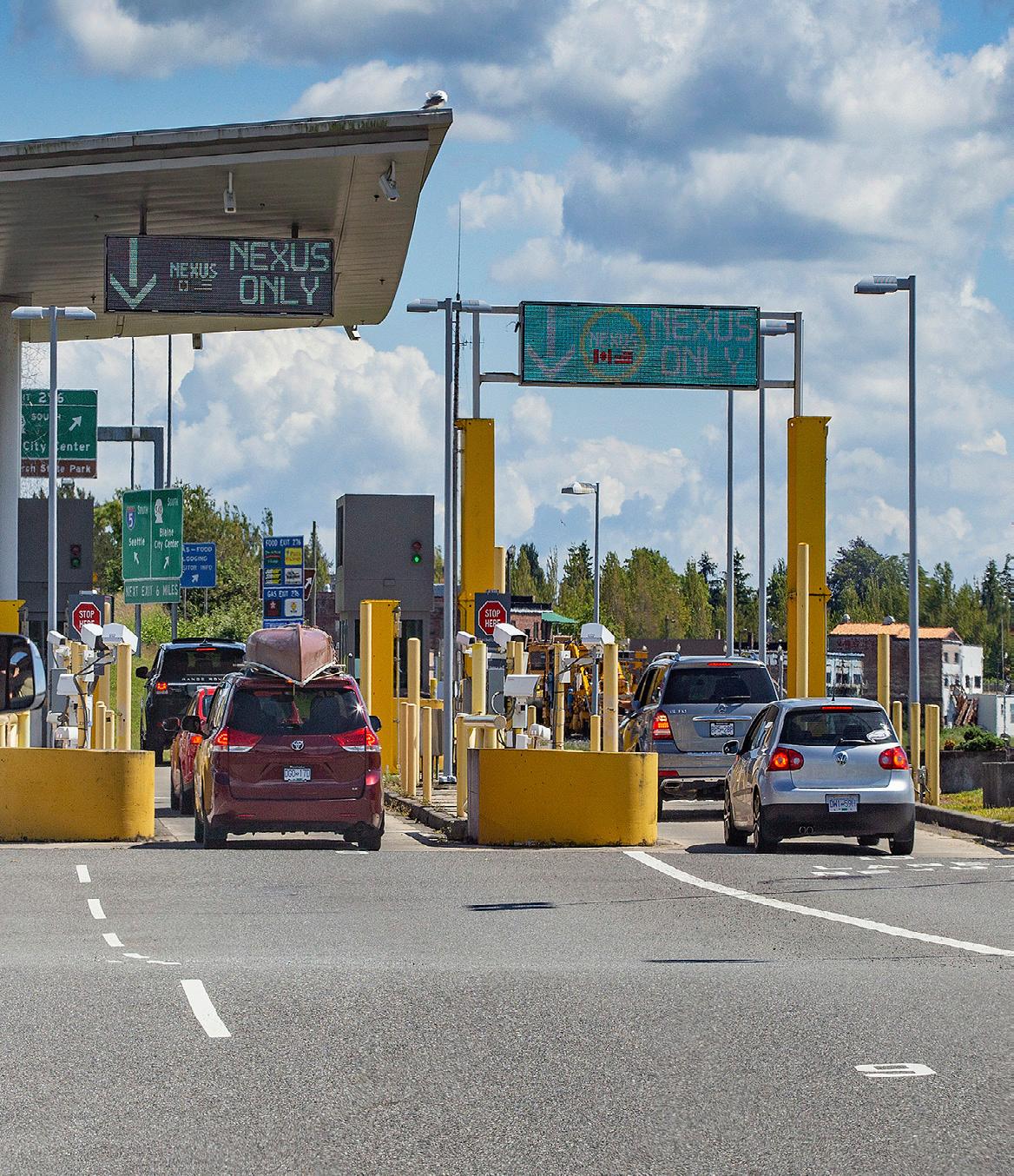
4 minute read
Border expectations — return to a prepandemic border seems unlikely
What can we expect at the border in 2021? A return to a pre-pandemic border seems unlikely
Laurie Trautman
On March 21, 2020, the United States and Canada took unprecedented bilateral action and restricted cross-border land travel to “essential” purposes. While commercial cargo, essential workers and a handful of other travelers are able to cross the border, the vast majority of travelers are prohibited. Both the U.S. and Canada have remained in lock step in their continual 30-day extensions of the border restrictions. Given the high rate of infection in the U.S. visà-vis Canada, and the overall state of the pandemic, these border restrictions are likely to remain in place until cross-border mobility can resume in a way that does not endanger public health.
As a result of the restrictions, crossings between British Columbia and Washington are down roughly 97%. The month of August is typically the busiest month for cross-border travel in our region, with an average of 400,000 cars crossing into Blaine. In August 2020, just 16,000 cars entered the U.S. at the Blaine crossing.The restrictions have had an immense economic impact on various sectors in Whatcom County, ranging from tourism to retail. In 2018, 5.4 million visitors from Canada traveled to Whatcom County, primarily to shop, pick up mail and buy gas. The Border Policy Research Institute at Western Washington University estimates that nearly 12% of Whatcom’s taxable retail sales are attributable to Canadians. In addition, Whatcom County’s hospitality sector, the Bellingham International Airport, and second-home ownership are all additional aspects of our economy that are impacted by Canadians and other cross-border travelers.
As we look to 2021, it is clear that the border restrictions are likely to remain in place for months to come. A best-case scenario would see the pandemic easing in both countries, with infection rates dropping to a level
The month of August is typically the busiest month for cross-border travel in our region, with an average of 400,000 cars crossing into Blaine. In August 2020, just 16,000 cars entered the U.S. at the Blaine crossing.
that both the U.S. and Canada view as manageable to enable the lifting of border restrictions. Perhaps we can accomplish this by late spring, aided by advancements in vaccine distribution. Regardless of infection rates, however, it is unlikely that we will return to a pre-pandemic border and more likely that testing or proof of vaccine will become a requirement for crossing the border. A number of airlines and airports around the world (including inbound flights to Hawaii) are already implementing testing protocols.
A worst-case scenario would imply
SUBSCRIBE TODAY!
1-year subscription (6 issues) $25 2-year subscription (12 issues) $45 3-year subscription (18 issues) $60
businesspulse.com/subscribe Stay informed with Whatcom County’s ONLY business news source! businesspulse.com/subscribe
Whatcom County, we’re here for you.
When you partner with us, you can count on experts who listen, learn and get to know your business, so we can provide solutions specifically tailored to your needs.
Respect, responsiveness and commitment. That’s been our approach for more than 130 years, and it’s what you and your business deserve—now more than ever.
Let’s create tomorrow, together.
Best Bank in the Pacific Region of the U.S., Two years in a row – Money Magazine
Connect with our Whatcom Commercial Banking Team: 360-752-8205
bannerbank.com Member FDIC that the border restrictions remain in place throughout 2021. This is a less likely situation for several reasons.
First, there is real progress being made both on a vaccine and on developing policies to screen for COVID19 at the border. In addition, maintaining the restrictions in their current state is not sustainable. Canada has already made several exemptions to the restrictions, recognizing the vital nature of the cross-border ties between our two countries not only because of our economic interdependence, but also for our families and loved ones. It is in both nations’ best interests to have a fluid border.
Canada and the U.S. have a history of working collaboratively to “thin” our shared border while also improving efficiency and security. Our border policy innovations have been successful because they have been aided by long-standing relationships anchored in trust. After facing a number of challenges to those relationships during the previous four years, we can expect a return to “normal” Canada-U.S. relations in 2021. This will re-establish a shared platform for policy collaboration that is necessary in order for cross-border mobility to resume.
Laurie Trautman is the director of the Border Policy Research Institute at Western Washington University. She engages in a range of research activities focused on the Washington–British Columbia region of the Canada-U.S. border. In addition to working with faculty and students, she collaborates with the private sector and government agencies to advance policy solutions and promote cross-border collaboration. Trautman participates in numerous working groups that are actively engaged in the U.S.-Canada relationship, and she is a member of the steering committee for the Cascadia Innovation Corridor. She also serves as a Global Fellow with the Woodrow Wilson Center and a Fellow with the Canadian Global Affairs Institute.


